Cuisine of Belarus

Belarusian national cuisine has evolved over the centuries. Belarusian culinary traditions represent a mix of simple recipes used by commoners and a sophisticated cuisine of the nobility, an extensive use of local ingredients and unusual way of cooking.
Old Belarusian recipes have survived to the present day, and the county’s visitors show an increased interest in them.
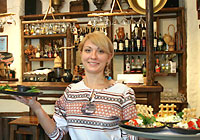 Restaurants serving Belarusian traditional food offer not only peasant cuisine of the Belarusian countryside but also elaborate dishes served to Belarusian magnates.
Restaurants serving Belarusian traditional food offer not only peasant cuisine of the Belarusian countryside but also elaborate dishes served to Belarusian magnates.
Traditional dishes are served at farmsteads that use only fresh farm produce to make the dishes which are often common only for a particular area.
Here they bake bread to old recipes and technologies, cook homemade meat delicacies, cheese from cow or goat's milk, and sweets made of honey, apples and cranberries.
Today’s diet of Belarusians includes many traditional dishes. The most popular are pork stew (machanka) and vereshchaka, homemade sausages, draniki (thick potato pancakes), kolduny, kletski (dumplings), babka (baked grated potato pie), cold sorrel soup, mushroom soup...
Old Belarusian Cuisine
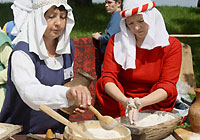 Belarusian cuisine was influenced by two main factors:
Belarusian cuisine was influenced by two main factors:
-
active farming and extensive use of local produce;
-
influences from neighboring countries and migrant settlers
Since the times of the Grand Duchy of Lithuania the national culinary traditions have been a mix of Baltic, Slavic, Jewish and partly German cuisines.
Therefore, the Belarusian cuisine is one of the most diverse in the continent. It is similar to the Russian, Lithuanian, Ukrainian, Polish, Jewish, but is unique in its own way, is hearty and delicious.
In the old days, each social class had its own gastronomic traditions. Therefore the Belarusian cuisine was divided into peasants and bourgeois, shlyakhta and high nobility cuisines.
The Belarusian cuisine widely uses local produce:
-
vegetables and greens (cabbages, turnips, beets, carrots, parsnips, pumpkins, potatoes, cucumbers, onions and garlic, sorrel, nettle, quinoa, orpine roots)
-
pulses (beans, peas, lentils, kidney beans)
-
grains (rye, barley, oats, buckwheat)
-
mushrooms (pickled, dried, powdered)
-
fruit and berries (apples, pears, plums, cherries, currants, blackberries, blueberries, red bilberries, raspberries, ashberries, high cranberries, canker berries)
-
spices and dressings (caraway, coriander, linseed, horseradish, calamus, mustard, juniper, cherry and oak leaves)
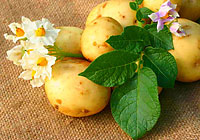 Potatoes deserve a special mention: being introduced to the diet of the Belarusians in the 18th century they have formed the basis of many Belarusian dishes for hundreds of years. Among them are famous draniki, kolduny, pyzy, potato sausage, kletski, babka…
Potatoes deserve a special mention: being introduced to the diet of the Belarusians in the 18th century they have formed the basis of many Belarusian dishes for hundreds of years. Among them are famous draniki, kolduny, pyzy, potato sausage, kletski, babka…
For centuries Belarusians consumed limited amounts of meat. Meat was usually served on festive occasions in the form of salted and sun-dried products. With time, the meat diet expanded. The most frequently used meat included:
-
pork
-
mutton
-
beef
-
poultry (chicken, duck, goose, turkey)
-
game (elk, roe, boar, beaver)
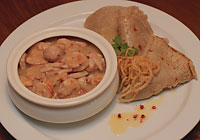 The Belarusian cuisine is a variety of meat and poultry dishes (pyachysta, kumpyachok, machanka, vereshchaka, tushanka, smazhanka), all sorts of home-made sausages, salty salo, byproduct dishes (vantrabyanka, rubtsy – pork belly stuffed with meat and buckwheat porridge), smoked meat…
The Belarusian cuisine is a variety of meat and poultry dishes (pyachysta, kumpyachok, machanka, vereshchaka, tushanka, smazhanka), all sorts of home-made sausages, salty salo, byproduct dishes (vantrabyanka, rubtsy – pork belly stuffed with meat and buckwheat porridge), smoked meat…
The Belarusian cuisine is also rich in fish dishes. As a rule, it is river fish (tench, sturgeon, pike, eelpout, bream, eel, trout, perch, carp). Belarusians used to make yushka, dumplings, salt and smoked fish. Today restaurants serve famous "Pike Perch a la Radziwill."
Common dairy products included curd cheese (made of cow and goat milk), sour cream, and butter. Milk is a regular ingredient in many Belarusian recipes, including all kinds of soups, porridges, mokanka.
The diet of Belarusian villagers was always hearty, relatively simple in cooking (many dishes were prepared in the oven over low heat for a long time), but always fresh: chilled or warmed food was not served!
Nobility cuisine was more exquisite, with a bigger variety of products and spices, including exotic ones, and, of course, and with the use of more sophisticated cooking technologies. The nobles had an opportunity to indulge themselves in such dishes as elk lips in sugared vinegar, stuffed eel, rooster broth...
Peculiarities of the Belarusian cuisine
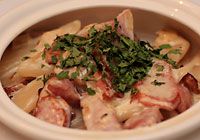 There are special features that distinguish the Belarusian cuisine from culinary traditions of many other countries, give it a local color and a peculiar charm.
There are special features that distinguish the Belarusian cuisine from culinary traditions of many other countries, give it a local color and a peculiar charm.
For example, the Belarusian cuisine is characterized by quite complicated and lengthy processing of products. It includes such methods as braising, stewing, baking, cooking, blanching and roasting, with several of them being used in some recipes.
Many national dishes require various kinds of flour made of oats, buckwheat, peas, rye and their mixtures.
Flour can be used as the main ingredient of some foods (flat cakes called perepecha, special Belarusian pancakes from various kinds of flour, thick pancakes made of peas). However, it can also serve as an additive for thickening ("zakolota" for soups). Traditionally yeast was not used in Belarus to knead dough.
The Belarusian cuisine offers a great variety of dishes made from vegetables. Many of them are unique despite the fact that they are based on traditional Slavonic recipes.
The examples are the soup zhur (cooked prior to Lent and can be alternatively made of milk or meat) based on oat water, polivka (thin soup made of cereals and vegetables), morkva (carrot soup), gryzhanka (turnip soup), garbuzok (pumpkin soup) and other kinds of dishes.
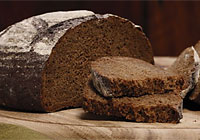 The pride of the national cuisine is traditional Belarusian bread baked with the use of rye flour. Instead of yeast Belarusians used a special leaven. This is a very healthy product.
The pride of the national cuisine is traditional Belarusian bread baked with the use of rye flour. Instead of yeast Belarusians used a special leaven. This is a very healthy product.
Belarusian bread is heavier and is a bit sour. In old recipes different additives were used like caraway seeds, linseeds and sunflower seeds. Bread was sometimes baked on the ‘pillow’ made from birch and oak leaves.
Belarusian cuisine today
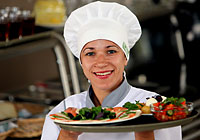 The contemporary Belarusian cuisine is eclectic. It has preserved old traditional recipes which are gradually being revived. Meanwhile dishes from other countries are becoming increasingly popular, too.
The contemporary Belarusian cuisine is eclectic. It has preserved old traditional recipes which are gradually being revived. Meanwhile dishes from other countries are becoming increasingly popular, too.
Today’s restaurants offer modern intake on traditional Belarusian dishes which reflect original ideas of chefs and principles of Grande cuisine, which takes into account the diversity of products and seasonal changes.
You will definitely appreciate such delicious dishes as:
-
Marinated white mushrooms with vegetable oil, hot potatoes, pieces of toasted wheat bread and leek
-
Zhur with eggs, smoked meat and sour cream
-
Cutlets from buckwheat and chopped meat (grechaniki) with sour cream and leek sauce
-
Draniki with apple and sour-cream sauce
-
Meat sauce (vereshchaka) with buckwheat pancakes
-
Bigos (a dish from sour cabbage) with smoked meat, mushrooms and prunes
-
Pyachisto (large pieces of gammon)
-
A pear roasted in honey with spices (the recipe of the Radziwill family)
In the 20th century, in the times of the Soviet Union, the Belarusians were widely exposed to the culinary traditions of other countries, like Russia, Ukraine, the Caucasus and Central Asia. In those times many West European meat dishes appeared on the menu of Belarusian restaurants and canteens.
The main changes that the Belarusian cuisine underwent in the 20th century were:
-
wheat flour and dishes from it became very popular (for centuries the Belarusians used mainly rye flour)
-
salads became quite common
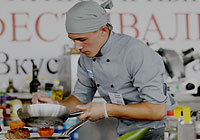 Today the menu of Belarusian restaurants features dishes of the Belarusian, European, and Asian cuisines, and modern culinary trends (wellness, fusion).
Today the menu of Belarusian restaurants features dishes of the Belarusian, European, and Asian cuisines, and modern culinary trends (wellness, fusion).
But if you are in Belarus, you must taste the national cuisine, the dishes that can be “Belarusian” only in Belarus.
You will see how delicious, interesting, sometimes even exclusive and unpredictable the Belarusian cuisine is!
Belarusian desserts
For many centuries honey has been the main dessert for the Belarusians. Solodukha (malt dough), kulaga (thick beverage made from berries, flour, sugar, and honey), and baked apples also were popular.
The recipes that are famous in Belarus include sweet pancakes with cottage cheese gravy and pears a la Radziwill.
Today the most popular desserts are:
-
ice-cream, whipped cream
-
cakes
-
fruits and berries (apples, pears, bilberry, cranberry, strawberry)
Vodka in Belarus
Vodka (Harelka) – is the most popular strong alcoholic beverage in Belarus. It appeared in the late 15th century and gradually became one of the most common types of alcohol. Belarusians drink vodka on holidays and special occasions.
To learn more about other popular alcoholic beverages and soft drinks click here.







 print version
print version make home page
make home page add to bookmarks
add to bookmarks










